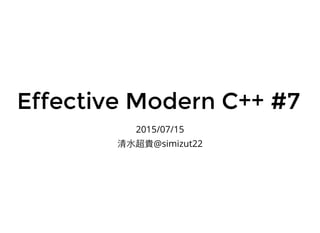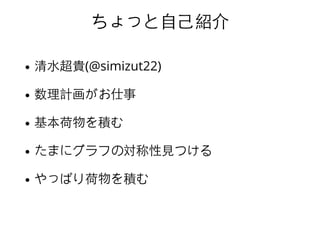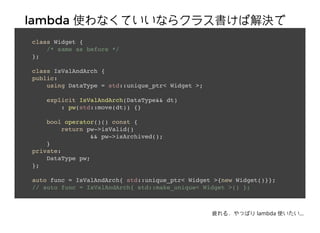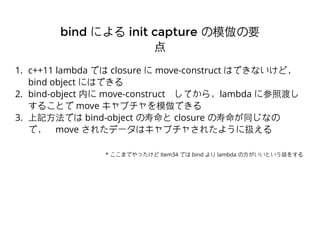emc++ chapter32
- 1. Effective Modern C++ #7Effective Modern C++ #7 2015/07/15 «Â?ÀÆ≥¨ŸF@simizut22
- 4. ≠˝§Ú≠˝§Úmove capturemove capture§∑§ø§§§∑§ø§§ class Widget { /* ... */ }; std::unique_ptr< Widget > pw; auto fun = [pw]{ /* do something */ }; …œ”õ•≥©`•…(compile ≤ªø…) container § §…§Úcopy§∑§ø§Ø§ §§ § §…§Œ§»§≠
- 5. ≥ı∆⁄ªØ•≠•„•◊•¡•„§Œòã?Œƒ≥ı∆⁄ªØ•≠•„•◊•¡•„§Œòã?Œƒ value capture reference capture [ data = (expression) ] [&data = (expression)] auto cmp = [eval = [](int i){ return -i;}] (int lhs, int rhs) { return eval(lhs) < eval(rhs);} expression § §Œ§« lambda §Ú?»Î§Ï§Î§Œ§‚§‚§¡§Ì§Ûø…ƒ‹
- 6. §¡§ §fl§À£¨◊Ó–¬§Œ gcc/msvc §œ¥Œ§‚ok http://melpon.org/wandbox/permlink/Gmqycg5tbA2iE51S using iVec = std::vector< int >; iVec data = iVec{1, 2, 3, 4, 5}; auto fun = [data{std::move(data)}] { std::copy(std::begin(data), std::end(data), [] () mutable { data.clear(): }}; prog.cc:9:19: warning: direct list initialization of a lambda init-capture will change meaning in a future version of Cla insert an '=' to avoid a change in behavior [-Wfuture-compat] auto f = [data{ std::move(data) } ] { ^ clang §¿§»¥Œ§Œ message§¨≥ˆ§Î ref: N3681 Auto and Braced-Init-Lists N3912 Atuto and Braced-Init-Lists, continued N3922 New Rules for auto deduction from braced-init-list
- 7. template< class T > struct wrap { mutable T value_; wrap(T&& v) : value_(std::forward< T >(v)) {} wrap(wrap const& other) : value_(std::move(other.value_)) {} }; struct Widget {}; auto pw = wrap< std::unique_ptr< Widget > >{std::make_unique< Widget >()}; auto fun = [pw]{ /* do something */ } §≥§Û§ wrapper §Úﯧا»§´... ref:N3610: Generic lambda-capture initializers C++14 § §È£¨≥ı∆⁄ªØ•≠•„•◊•¡•„©`§«§«§≠§Î
- 8. class Widget { public: /* ... */ bool isValidated() const; bool isProessed() const; bool isAchieved() const; private: /* ... */ }; auto pw = std::make_unique< Widget >(); /** * configure *pw **/ auto func = [pw = std::move(pw)] { return pw->isValidated() && pw->isAchived();}; /** * pw is moved to data member pw of closure **/ §≥§¶§ §Î
- 9. …œ”õ§Œ•≥©`•…§«§œ 1. closure§À•«©`•ø•·•Û•–©` pw §Ú◊˜≥…§∑§∆ 2. local ≠˝ pw §Ú move §∑§∆ 3. •·•Û•–©`pw §Ú≥ı∆⁄ªØ §Ú§‰§√§∆§§§Î [pw = std::move(pw)] { /* do something */}; §‚§∑ con?gure pw §Œ≤Ÿ◊˜§¨≤ª“™§ §È£¨ ≥ı∆⁄ªØ§Ú capture §»Õ¨ïr§À§‰§Ï§–§Ë§§ [pw = std::make_unique< Widget >()] () { /* do something */ };
- 10. lambdalambda π§Ô§ §Ø§∆§§§§§ §È•Ø•È•πﯧ±§–Ω‚õQ§« π§Ô§ §Ø§∆§§§§§ §È•Ø•È•πﯧ±§–Ω‚õQ§« §≠§Î§≠§Îclass Widget { /* same as before */ }; class IsValAndArch { public: using DataType = std::unique_ptr< Widget >; explicit IsValAndArch(DataType&& dt) : pw(std::move(dt)) {} bool operator()() const { return pw->isValid() && pw->isArchived(); } private: DataType pw; }; auto func = IsValAndArch{ std::unique_ptr< Widget >{new Widget()}}; // auto func = IsValAndArch{ std::make_unique< Widget >() }; ∆£§Ï§Î£Æ§‰§√§—§Í lambda 𧧧ø§§...
- 11. §Ω§Ï§Ω§Ï bindbind §«§«§≠§Î§Ë§«§«§≠§Î§Ë!!!! 1. (move)•≠•„•◊•¡•„©`§∑§ø§§â‰ ˝§Ú bind object ƒ⁄§Àmove§π§Î 2. "•≠•„•◊•¡•„©`"§∑§ø≠˝§Œ≤Œ’’§Ú•È•‡•¿§Œ“˝ ˝§À§π§Î §Ú§π§Ï§–§Ë§§ /** c++ 14 init capture **/ using dVec = std::vector< double >; dVec data; /* configure data */ auto func = [data = std::move(data)] { /* do somthing */ }; /** use std::bind for c++11 **/ using dVec = std::vector< double >; dVec data; /* configure data */ auto func = std::bind([](dVec const&) // (2) ^^^^^^^^^^^^ {/* do somthing */} , std::move(data)); // (1) ^^^^^^^^^^^^^^^ æflõƒ§ •≥©`•…§œ“‘œ¬
- 12. bindbind §»§» closureclosure §Œfl`§§§Œfl`§§ /** c++ 14 init capture **/ std::vector< double > data; /* cofigure data */ auto func = [data = std::move(data)] { data.clear() }; /** bind version **/ std::vector< double > data; /** config data **/ auto func = std::bind([](std::vector< double > v&) { v.clear(); } , std::move(data)); §≥§Ï§Ú”fi÷±§Àﯧ≠ìQ§®§Î§»
- 13. http://melpon.org/wandbox/permlink/3bIhkKfDDlQhXREr Start prog.cc:7:19: error: member function 'clear' not viable: 'this' argument has type 'const std::__1: { data.clear(); }; ^~~~ /usr/local/libcxx-head/include/c++/v1/vector:735:10: note: 'clear' declared here void clear() _NOEXCEPT ^ 1 error generated. clang3.7.0 build §∑§∆§fl§ø ClosureType::operator() §œ •«•’•©•Î•»§«§œconst method mutable speci?er §Ú∏∂§±§Î§» non-const method §¨∫Ù§–§Ï§Î(…œ§œ const method §Ú∫Ù§Û§«§Î) auto fun = [data = std::move(data)] () mutable { data.clear(); }; // ^^^^^^^ §≥§Ï§«?¥Û’…∑Ú!(^^)! ** mutable §Ú∏∂§±§Î§»§≠§À§œ argument parameter list §¨±ÿ“™ http://melpon.org/wandbox/permlink/zzoa3WK54NxBz7Ac
- 14. bind object §Œ?…˙¥Ê∆⁄Èg auto makeFun() // sorry this is c++14 { std::vector< int > data{1,2,3,4,5}; auto fun = [](const std::vector< int >& v) { std::copy(v.begin(), v.end(), std::ostream_iterator< int >(std::cout, " "));}; return std::bind(fun, std::move(data)); // data is copied in bind obj } auto&& fun = makeFun(); fun(); // ok œ»§À ˆ§Ÿ§ø bind + lambda §Ú?”√§§§ø?∑Ω∑®§Ú π§√§øïr bind object §Œ?…˙¥Ê∆⁄Èg = closure object(?rst argument )§Œ?…˙¥Ê∆⁄Èg = move "capture" §µ§Ï§ø data §Œ?…˙¥Ê∆⁄Èg §¨§ §Í§ø§ƒ èæ§√§∆£¨capture §µ§Ï§ø data §Ú closure §´§È∫Ù§÷§≥§»§ÀÜñÓ}§œ§ §§
- 15. 1. c++11 lambda §«§œ closure §À move-construct §œ§«§≠§ §§§±§…£¨ bind object §À§œ§«§≠§Î 2. bind-object ƒ⁄§À move-construct°°§∑§∆§´§È£¨lambda §À≤Œ’’∂…§∑ §π§Î§≥§»§« move •≠•„•◊•¡•„§Úƒ£Ç秫§≠§Î 3. …œ”õ?∑Ω∑®§«§œ bind-object §Œ Ÿ√¸§» closure §Œ Ÿ√¸§¨Õ¨§∏§ §Œ §«£¨°°move §µ§Ï§ø•«©`•ø§œ•≠•„•◊•¡•„§µ§Ï§ø§Ë§¶§ÀíQ§®§Î bindbind §À§Ë§Î§À§Ë§Î init captureinit capture §Œƒ£Ç秌“™§Œƒ£Ç秌“™ µ„µ„ * §≥§≥§fi§«§‰§√§ø§±§… Item34 §«§œ bind §Ë§Í lambda §Œ?∑Ω§¨§§§§§»§§§¶‘í§Ú§π§Î
- 16. Things to RememberThings to Remember closure ƒ⁄§À objects §Ú move §π§Î§ §È c++14 init capture §Ú 𧙧¶ ÷±§À•Ø•È•π§Úﯧا´ bind §Ú 𧮧– init-capture §œ emulate §«§≠§Î



![≠˝§Ú≠˝§Úmove capturemove capture§∑§ø§§§∑§ø§§
class Widget {
/* ... */
};
std::unique_ptr< Widget > pw;
auto fun = [pw]{ /* do something */ };
…œ”õ•≥©`•…(compile ≤ªø…)
container § §…§Úcopy§∑§ø§Ø§ §§
§ §…§Œ§»§≠](https://image.slidesharecdn.com/emcppchapter32-150716031207-lva1-app6891/85/emc-chapter32-4-320.jpg)
![≥ı∆⁄ªØ•≠•„•◊•¡•„§Œòã?Œƒ≥ı∆⁄ªØ•≠•„•◊•¡•„§Œòã?Œƒ
value capture
reference capture
[ data = (expression) ]
[&data = (expression)]
auto cmp =
[eval = [](int i){ return -i;}] (int lhs, int rhs)
{ return eval(lhs) < eval(rhs);}
expression § §Œ§« lambda §Ú?»Î§Ï§Î§Œ§‚§‚§¡§Ì§Ûø…ƒ‹](https://image.slidesharecdn.com/emcppchapter32-150716031207-lva1-app6891/85/emc-chapter32-5-320.jpg)
![§¡§ §fl§À£¨◊Ó–¬§Œ gcc/msvc §œ¥Œ§‚ok
http://melpon.org/wandbox/permlink/Gmqycg5tbA2iE51S
using iVec = std::vector< int >;
iVec data = iVec{1, 2, 3, 4, 5};
auto fun = [data{std::move(data)}]
{ std::copy(std::begin(data),
std::end(data),
[] () mutable
{ data.clear(): }};
prog.cc:9:19: warning:
direct list initialization of a lambda init-capture will change meaning in a future version of Cla
insert an '=' to avoid a change in behavior [-Wfuture-compat]
auto f = [data{ std::move(data) } ] {
^
clang §¿§»¥Œ§Œ message§¨≥ˆ§Î
ref:
N3681 Auto and Braced-Init-Lists
N3912 Atuto and Braced-Init-Lists, continued
N3922 New Rules for auto deduction from braced-init-list](https://image.slidesharecdn.com/emcppchapter32-150716031207-lva1-app6891/85/emc-chapter32-6-320.jpg)
![template< class T >
struct wrap {
mutable T value_;
wrap(T&& v) : value_(std::forward< T >(v)) {}
wrap(wrap const& other) : value_(std::move(other.value_)) {}
};
struct Widget {};
auto pw = wrap< std::unique_ptr< Widget > >{std::make_unique< Widget >()};
auto fun = [pw]{ /* do something */ }
§≥§Û§ wrapper §Úﯧا»§´...
ref:N3610: Generic lambda-capture initializers
C++14 § §È£¨≥ı∆⁄ªØ•≠•„•◊•¡•„©`§«§«§≠§Î](https://image.slidesharecdn.com/emcppchapter32-150716031207-lva1-app6891/85/emc-chapter32-7-320.jpg)
![class Widget {
public:
/* ... */
bool isValidated() const;
bool isProessed() const;
bool isAchieved() const;
private:
/* ... */
};
auto pw = std::make_unique< Widget >();
/**
* configure *pw
**/
auto func = [pw = std::move(pw)]
{ return pw->isValidated()
&& pw->isAchived();};
/**
* pw is moved to data member pw of closure
**/
§≥§¶§ §Î](https://image.slidesharecdn.com/emcppchapter32-150716031207-lva1-app6891/85/emc-chapter32-8-320.jpg)
![…œ”õ§Œ•≥©`•…§«§œ
1. closure§À•«©`•ø•·•Û•–©` pw §Ú◊˜≥…§∑§∆
2. local ≠˝ pw §Ú move §∑§∆
3. •·•Û•–©`pw §Ú≥ı∆⁄ªØ
§Ú§‰§√§∆§§§Î
[pw = std::move(pw)] { /* do something */};
§‚§∑ con?gure pw §Œ≤Ÿ◊˜§¨≤ª“™§ §È£¨
≥ı∆⁄ªØ§Ú capture §»Õ¨ïr§À§‰§Ï§–§Ë§§
[pw = std::make_unique< Widget >()] () { /* do something */ };](https://image.slidesharecdn.com/emcppchapter32-150716031207-lva1-app6891/85/emc-chapter32-9-320.jpg)

![§Ω§Ï§Ω§Ï bindbind §«§«§≠§Î§Ë§«§«§≠§Î§Ë!!!!
1. (move)•≠•„•◊•¡•„©`§∑§ø§§â‰ ˝§Ú bind object ƒ⁄§Àmove§π§Î
2. "•≠•„•◊•¡•„©`"§∑§ø≠˝§Œ≤Œ’’§Ú•È•‡•¿§Œ“˝ ˝§À§π§Î
§Ú§π§Ï§–§Ë§§
/** c++ 14 init capture **/
using dVec =
std::vector< double >;
dVec data;
/* configure data */
auto func =
[data = std::move(data)]
{ /* do somthing */ };
/** use std::bind for c++11 **/
using dVec =
std::vector< double >;
dVec data;
/* configure data */
auto func =
std::bind([](dVec const&)
// (2) ^^^^^^^^^^^^
{/* do somthing */}
, std::move(data));
// (1) ^^^^^^^^^^^^^^^
æflõƒ§ •≥©`•…§œ“‘œ¬](https://image.slidesharecdn.com/emcppchapter32-150716031207-lva1-app6891/85/emc-chapter32-11-320.jpg)
![bindbind §»§» closureclosure §Œfl`§§§Œfl`§§
/** c++ 14 init capture **/
std::vector< double > data;
/* cofigure data */
auto func =
[data = std::move(data)]
{ data.clear() };
/** bind version **/
std::vector< double > data;
/** config data **/
auto func =
std::bind([](std::vector< double > v&)
{ v.clear(); }
, std::move(data));
§≥§Ï§Ú”fi÷±§Àﯧ≠ìQ§®§Î§»](https://image.slidesharecdn.com/emcppchapter32-150716031207-lva1-app6891/85/emc-chapter32-12-320.jpg)
![http://melpon.org/wandbox/permlink/3bIhkKfDDlQhXREr
Start
prog.cc:7:19: error: member function 'clear' not viable: 'this' argument has type 'const std::__1:
{ data.clear(); };
^~~~
/usr/local/libcxx-head/include/c++/v1/vector:735:10: note: 'clear' declared here
void clear() _NOEXCEPT
^
1 error generated.
clang3.7.0
build §∑§∆§fl§ø
ClosureType::operator() §œ
•«•’•©•Î•»§«§œconst method
mutable speci?er §Ú∏∂§±§Î§» non-const method
§¨∫Ù§–§Ï§Î(…œ§œ const method §Ú∫Ù§Û§«§Î)
auto fun = [data = std::move(data)] () mutable
{ data.clear(); }; // ^^^^^^^
§≥§Ï§«?¥Û’…∑Ú!(^^)!
** mutable §Ú∏∂§±§Î§»§≠§À§œ argument parameter list §¨±ÿ“™
http://melpon.org/wandbox/permlink/zzoa3WK54NxBz7Ac](https://image.slidesharecdn.com/emcppchapter32-150716031207-lva1-app6891/85/emc-chapter32-13-320.jpg)

{ std::copy(v.begin(), v.end(),
std::ostream_iterator< int >(std::cout, " "));};
return std::bind(fun, std::move(data)); // data is copied in bind obj
}
auto&& fun = makeFun();
fun(); // ok
œ»§À ˆ§Ÿ§ø bind + lambda §Ú?”√§§§ø?∑Ω∑®§Ú π§√§øïr
bind object §Œ?…˙¥Ê∆⁄Èg
= closure object(?rst argument )§Œ?…˙¥Ê∆⁄Èg
= move "capture" §µ§Ï§ø data §Œ?…˙¥Ê∆⁄Èg
§¨§ §Í§ø§ƒ
èæ§√§∆£¨capture §µ§Ï§ø data §Ú closure §´§È∫Ù§÷§≥§»§ÀÜñÓ}§œ§ §§](https://image.slidesharecdn.com/emcppchapter32-150716031207-lva1-app6891/85/emc-chapter32-14-320.jpg)

